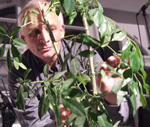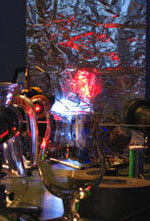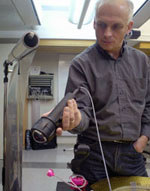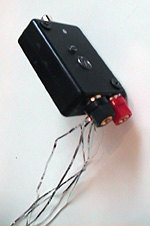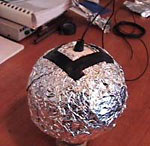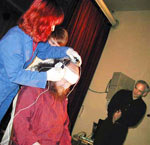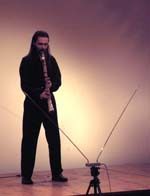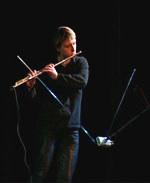contact
MOMus
Museum of Modern Art
Costakis Collection
21 st Kolokotroni Str.
Moni Lazariston
56430, Stavroupoli
Greece
| Selected works | |
| Sensor-Garden installation (2006-2007) | |
|
Several plants are connected to the theremin-sensors as a kind of live antennas. Performers and spectators can interact with those plants touching their leaves, branches and trunks. MAX/MSP based interactive algorhythms are analyzing and interpreting incoming sensor data controlling pre-programmed sound generative processes. Different ways of interaction as well as different locations produce different musically meaningful audio reactions. more info |
| Laser Bugging performance (since 2005) | |
|
This installation/performance is a sort of sound/light alchemy, a play with light, reflecting materials and chemical processes. In the core of the installation/performance is a reconstruction of Leon Theremin's "Buran" eavesdropping system, developed in 1945 for KGB, based on monitoring of the acoustical vibrations of windowpanes. Therefore he used a radio-location system based on directed microwave radiation. Equipment needed for the performance: |
| Windowpane Theremin installation (2005) | |
|
Installation is based on a reconstruction of Leon Theremin's "Buran" eavesdropping system, capable to monitor acoustical vibrations of windowpanes. It incorporates a laser and a photo receiver, both installed at a 10 to 20 m distance from a window. The light from the laser is focussed on the windowpane and eavesdroppes all activity in it's neighborhood. Sounds are distorted by the glass-surface resonances. Equipment needed for the installation: |
| Vetro-Touchless installation (2005) | |
|
The installation is based on several vetro-sensors (theremin-sensors with a very light, flexible antennas), hanged over the exhibition space. The space should have windows or doors, which could be opened to produce air flows. All sensors are connected to the computer with MAX/MSP software. more info |
| Vetro-Touchless performance (2005) | |
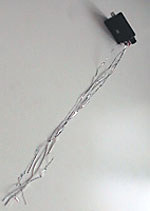 |
Performance is based on the same techniques, played by two performers: one dancer and one programmer. V:NM Festival, Graz, Austria more info |
| SonoCHronoTop installation (since 2002) | |
|
For theremin-sensores and MAX/MSP based interactive system. Sonochronotop is a sort of virtual musical instrument as well as an active sonic space, a kind of invisible sculpture, in which the sound (sono-), it’s development in time (chrono-) and active motion in space (topos) are linked together and the spatial structure of musical performance could only be developed and displayed as a result of transformation of a biodynamic tissue of motion into the sensual tissue of musical sound. There are several embodyments of SonoCHronoTop, including the series of interactive musical performances in collaboration with Dmitry Kalinin (schakuhachi), Peter van Bergen (sax), Cordula Bösze (flute), "Shadows" installation together with Elisabeth Schimana, new "solo" SonoCHronoTop installation series. |
| Brain JAZZ (1985/2001) | |
|
Interactive performance/installation for one soloist, one programmer, two assistants, MAX/MSP based interactive brain-wave biofeedback system. |
| SonoCHronoTop performance (2000) | |
|
for one performer, theremin-sensores and MAX/MSP based interactive system. Sonochronotop is a sort of virtual musical instrument as well as an active sonic space, a kind of invisible sculpture, in which the sound (sono-), it’s development in time (chrono-) and active motion in space (topos) are linked together and the spatial structure of musical performance could only be developed and displayed as a result of transformation of a biodynamic tissue of motion into the sensual tissue of musical sound. VIDEO (12.6 mb) |
